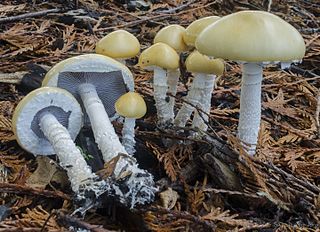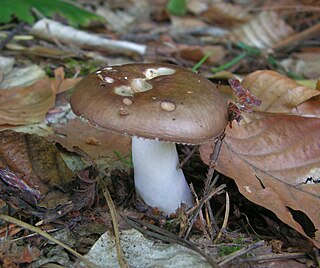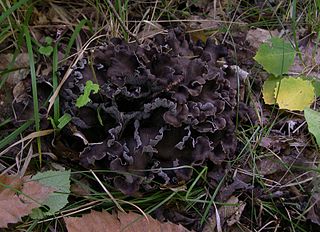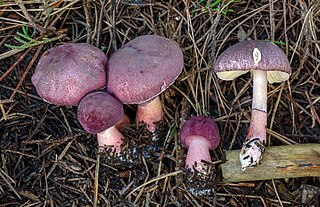
Chanterelle is the common name of several species of fungi in the genera Cantharellus, Craterellus, Gomphus, and Polyozellus. They are orange, yellow or white, meaty and funnel-shaped. On the lower surface, most species have rounded, forked folds that run almost all the way down the stipe, which tapers down from the cap. Many species emit a fruity aroma and often have a mildly peppery taste.
Black chanterelle is a common name of several fungi species and can refer to:

Cantharellus is a genus of mushrooms, commonly known as chanterelles, a name which can also refer to the type species, Cantharellus cibarius. They are mycorrhizal fungi, meaning they form symbiotic associations with plants. Chanterelles may resemble a number of other species, some of which are poisonous.

Craterellus cornucopioides, or horn of plenty, is an edible mushroom found in North America and Eurasia. It is also known as the black chanterelle, black trumpet, trompette de la mort (French), trompeta de la mort (Catalan) or trumpet of the dead.

Panaeolus cinctulus, syn. Panaeolus subbalteatus, commonly known as the banded mottlegill, weed Panaeolus, belted panaeolus, or subbs is a very common, widely distributed psilocybin mushroom. According to American naturalist and mycologist David Arora, Panaeolus cinctulus is the most common psilocybin mushroom in California.

Hydnum repandum, commonly known as the sweet tooth, pig's trotter, wood hedgehog or hedgehog mushroom, is a basidiomycete fungus of the family Hydnaceae. First described by Carl Linnaeus in 1753, it is the type species of the genus Hydnum. The fungus produces fruit bodies (mushrooms) that are characterized by their spore-bearing structures—in the form of spines rather than gills—which hang down from the underside of the cap. The cap is dry, colored yellow to light orange to brown, and often develops an irregular shape, especially when it has grown closely crowded with adjacent fruit bodies. The mushroom tissue is white with a pleasant odor and a spicy or bitter taste. All parts of the mushroom stain orange with age or when bruised.

David Arora is an American mycologist, naturalist, and writer. He is the author of two popular books on mushroom identification, Mushrooms Demystified and All That the Rain Promises and More....

Craterellus tubaeformis is an edible fungus, also known as yellowfoot, winter mushroom, or funnel chanterelle. It was reclassified from Cantharellus, which has been supported by molecular phylogenetics.

Stropharia ambigua, sometimes known as the questionable Stropharia, is a saprotrophic agaric mushroom, commonly fruiting in leaf litter and wood chips in the Pacific Northwest.

Gomphus clavatus, commonly known as pig's ears or the violet chanterelle, is an edible species of fungus in the genus Gomphus native to Eurasia and North America. Described by Jacob Christian Schäffer in 1774, G. clavatus has had several name changes and many alternative scientific names, having been classified in the genus Cantharellus, though it is not closely related to them. The fruit body is vase- or fan-shaped with wavy edges to its rim, and grows up to 15–16 cm wide and 17 cm tall. The upper surface or cap is orangish-brown to lilac, while the lower spore-bearing surface, the hymenium, is covered in wrinkles and ridges rather than gills or pores, and is a distinctive purple color.

Polyozellus is a fungal genus in the family Thelephoraceae, a grouping of mushrooms known collectively as the leathery earthfans. Previously considered a monotypic genus, it now contains the Polyozellus multiplex species complex. The genus name is derived from the Greek poly meaning many, and oz, meaning branch. It is commonly known as the blue chanterelle, the clustered blue chanterelle, or, in Alaska, the black chanterelle. The distinctive fruit body of this species comprises blue- to purple-colored clusters of vase- or spoon-shaped caps with veiny wrinkles on the undersurface that run down the length of the stem.

Polyozellus multiplex is a species complex of fungi first described in 1899. P. multiplex is commonly known as the blue chanterelle, the purple chanterelle, or, in Alaska, the black chanterelle. However, this mushroom is not closely related to true chanterelles. While this name used to refer to a group of species, it is now used to describe only one species that held onto the name P. multiplex. The fruiting bodies of this species are blue- to purple-colored clusters of vase- or spoon-shaped caps, with veiny wrinkles on the underside which run down the length of the stem. P. multiplex was considered the monotypic species of the genus Polyozellus until recent molecular research divided the P. multiplex species complex into five species. The genus name is derived from the Greek poly meaning many, and oz, meaning branch. The specific epithet multiplex means "in many pieces," referring to the compound nature of the fruiting body.

Russula integra, commonly known as the entire russula, is a species of mushroom. The fungus stems from the huge genus of Russula. It is found in conifer forests across Europe and throughout North America. The fruiting body is mildly flavoured with a slight cashew-like taste and dense flesh. It is edible and most commonly consumed in Central Europe.

Cantharellus formosus, commonly known as the Pacific golden chanterelle, is a fungus native to the Pacific Northwest region of North America. It is a member of the genus Cantharellus along with other popular edible chanterelles. It was distinguished from C. cibarius in the 1990s. It is orange to yellow, meaty and funnel-shaped. On the underside of the smooth cap, it has gill-like ridges that run down onto its stipe, which tapers down from the cap. The false gills often have a pinkish hue. It has a mild, sweet odor.

Cantharellus subalbidus, the white chanterelle, is a fungus native to western North America. It is a member of the genus Cantharellus along with other popular edible chanterelles. It is similar in appearance to other chanterelles except for its cream to white color and orange bruising.

Cantharellus californicus, also called the California golden chanterelle, mud puppy, or oak chanterelle, is a fungus native to California, United States. It is a member of the genus Cantharellus along with other popular edible chanterelles. It is generally similar in appearance to C. cibarius and C. formosus except for its large size at maturity.

Craterellus cinereus, commonly known as the black chanterelle or ashen chanterelle, is a species of Craterellus found growing in coniferous forest in Europe.

Lepiota decorata, also known as the pink parasol, is an uncommon species of gilled mushroom found in North America. The cap of L. decorata usually has a speckled violet pattern, stains orange when scratched, and is about 4 to 8 cm in diameter.

Helvella compressa, also known as the compressed elfin saddle, is a species of ascomycete "sac fungus" related to the Peziza cups. Helvella compressa is endemic to North America west of the Rocky Mountains. According to David Arora, H. compressa "seems to be the most common" of the non-fluted Helvellas found in California. Helvella compressa is possibly also present in China and Tibet.

Calvatia pachyderma, also known as the elephant-skin puffball or thick-skinned puffball, is a species of edible fungus. This mid-sized, spring-fruiting puffball is known from relatively dry, open places near human settlements. The appropriate binomial name, taxonomic placement, and geographic distribution "have been much debated and are the subject of controversy".



















